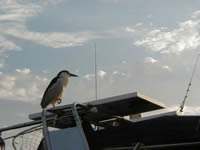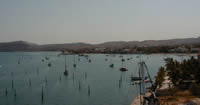HOME |
LOGBOOK |
|
Volume 71 Arrival in Baja
On May 18, dawn broke about 0600 to reveal the long reddish mountain range of Baja. What a spectacular arrival, striking from even eight miles off! Baja California is a product of the same geological fault that shakes up California now and then, the peninsula ever so gradually splitting away from the mainland over eons. If you picture the peninsula as a long wide plank, the tectonic splitting motion is lifting the eastern edge while the broad top is depressed to become a long slope to the west. This has produced the dramatic sheer eastern face that makes this coast such a memorable cruising ground. But clearly that's not all that's gone on. As we sailed closer and closer, the rock diversified into a huge range of colors, textures, ravines and strata! And very, very little of that color is green! As desolate and uninhabited (uninhabitable?) as the terrain appeared as we rounded the north end of Isla Cerralvo, man's presence was quickly revealed by several dozen fishing boats working the rich waters of the island's tip. Some were panga style and others were sportfishermen. Fishing is probably THE big attraction in Baja. There are dozens of guidebooks written detailing where the fish are to be found, and when, and how the determined angler can find them. A popular means for fishermen without multi-zillion dollar mega-yachts or sportfish boats at their disposal is to truck in a skiff on a trailer. All along the Gulf are rustic trailer parks and fishing camps catering to this addiction. We saw our first of these a couple of hours later on the Playa Tecolote as we passed through the Canal de San Lorenzo into the Bahia de La Paz. The Bahia de La Paz is a huge area of water bounded on the east by a north-thrusting promontory and a string of islands and encircled on the west by the Baja "mainland". This part of the Baja peninsula is fairly low and narrow, which forecasters predict will someday make it an island. The city of La Paz is all the way at its south end tucked into a funky mini bay of its own, and from the Lorenzob channel there is still nothing to suggest that it's there!
We dropped the hook in one of the southern scallops and spent four content days gradually being indoctrinated into some of the realities of Baja. The very first reality were the "bobos," tiny little flies that persist in flying in your nose, mouth, ears and eyes or landing with amazingly heavy footfalls in the same location from which you just swatted them. Fortunately, they don't bite. Fortunately they aren't everywhere. The second reality was the Corumuels. An early summer phenomenon, Corumuels are southwesterly winds that begin to pipe in the late afternoon and early evening, originating in La Paz and spreading northward up the bay for a hundred or so miles. The nice thing about the Corumuels is their very first stirrings chase away the bobos and cool the hot afternoon air temps. The bad thing about them is they keep building and building and building! Usually they top out around 20-25 kts, but they can blow harder than that! Although we had planned for them (being faithful readers of all guidebooks) and had anchored close to the southern cliff face for protection, they still managed to keep the boat in a steady state of bounce and shiver most of the night! This did not make for the most restful sleep that first night, but it sure kept the wind generator humming. Indeed the third reality of Baja is going to be the success of our alternate energy sources. Between the strong sun during the day and the wind at night, we haven't had to use any exterior charging on our batteries since we arrived! The fourth reality of Baja is that no matter how desolate the terrain and how remote you feel your anchorage is, mankind is around. On the weekend, the beaches of Balandra filled with beachgoers from some unseen parking lot, the waters hummed with jet skis and small runabouts, and cruising boats came and went coming and going from La Paz! And finally, the fifth reality of our Baja 101 lesson is that the wind can come from anywhere, and eventually will! On our last evening in Balandra, the wind clocked around to the north! This put our protecting cliff suddenly on our stern while wrap-around swell turned our placid corner into a washing machine! We happened to have couple from a powerboat we'd first met in Acapulco over for drinks, and all four of us had to have a death grip to keep from being tossed from our seats. That they stayed aboard gives you an idea how badly their round-bottomed boat was rolling. Without a keel it was double-timing TII's motion! So, although we had planned to go into La Paz the next day, anyway, our anchor was up the moment the coffee was poured!!!! Which reminds me to mention yet another reality of Baja. It's COLD in the morning. If the wind isn't blowing it's brisk enough at 63 degrees, but a 20-knot wind can add a lot of wind chill! We're sleeping under two blankets and we do coffee in long sleeves and sweats! This is all the more amazing when you know it's going to be 95-100 by mid-afternoon! Intro to La Paz
There are two full-scale marinas in La Paz, Marina de la Paz in town and Marina Palmyra (home of the small Moorings fleet) out of town, plus several smaller ones that seem to be mostly long-termers. There is a huge anchorage area paralleling town between a sand bar and the Mogote, a very large sand island protecting the town and harbor. The substantial tidal flow and the Corumuel winds make the anchored boats move around in what is known as "The La Paz Waltz," but there is much more room than we'd imagined. There are also at least five boatyards, and just to make it really confusing, three of them are owned by members of the Abaroa family. Then to top things off there are a half dozen marine stores that actually have stuff! Including stuff for sailboats. From Colombia west, this has been a rarity! We chose to make our debut in La Paz by spending the bucks for a slip at Marina de La Paz, mostly so that we would have easy access not just to the town but to the informed experience of the marina management who are former cruisers themselves. We thought we were just going in to scope things out and make some plans for later in the month, but to our utter amazement, things got rolling so quickly that, presto, seventeen days later we were sailing out of the harbor having checked most every project off our To Do list. That list included haul out, bottom paint, insurance survey, hyro-testing of the scuba tanks, inspection of the fire extinguishers, new latches for the ice boxes, various canvas projects and repairs, and even the purchase of a new kayak! There was even time for a few things NOT to go so smoothly, but as Don plans an Engine Room entry on these misadventures, I'll leave that saga for him to tell. The town of La Paz fronts
a long waterfront with a very pleasing malecon stretching its length,
the perfect venue for sunset strolls. A lot of But, the real joys of Baja are going to be its remote anchorages tucked into stunning landscapes. Much of the cruising crowd is well ahead of us. Old timers tell us the flow was early this year because a popular cruiser festival took place a month early up in Loreto. Many of our friends, in fact, have already reached San Carlos (Siesta & Sandi Lee, for example) where they will haul out and leave their boats for the summer. Others have plugged into long terms slips in La Paz, while a few have gone so far as to bash back to California. What's amazing about this is that the winds have just begun to get their southerly component for sailing, the water temperature is still chilly, the clarity of the water is still low for diving, and the dorado are just arriving! The season is really only just beginning! On the other hand, there have already been two tropical systems - Hurricane Alma and TS Boris - that have set our guts to their seasonal churning. Nothing has come close, and real threats here are usually few and far between. After all, we are north of 24 degrees north! Still, like the Caribbean this cruising Paradise is not without its anxieties, and the 2Cs are on the alert. Meanwhile, we are proceeding at our own very leisurely pace, and enjoying it.
|
|
home
| waypoints | logbook | reference shelf
|




